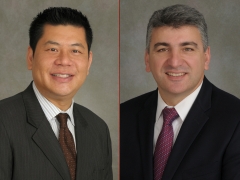Aortic disease is serious and potentially life-threatening, often occurring "silently" without any symptoms.
For this reason early detection and treatment are crucial. It's important for people to understand that when affected by disease, the blood vessel (artery) called the aorta can split (dissection) or bulge (aneurysm) and, in either case, the rupture may have fatal results.
Here, Apostolos K. Tassiopulos, MD, professor of surgery, chief of our Vascular and Endovascular Surgery Division and co-director of the Stony Brook Aortic Center, and Shang A. Loh, MD, assistant professor of surgery and also a leader of the Aortic Center, answer questions about aortic disease and about the care we provide for it.
Q: What should I know about the aorta and aortic problems?
A: The aorta is the main vessel carrying oxygenated blood from the left ventricle of the heart to other parts of the body. The aorta ascends from the top of the heart, arches up and over it, descends through the chest behind the lungs and in front of the spine to the abdomen, and then branches off at the pelvis.
Aortic diseases can occur for many reasons and often develop in tandem with coronary artery disease. The biggest risk factors for aortic diseases are being male, over age 55, a smoker and having high blood pressure or heart disease — but anyone can develop an aortic condition at any age.
When your doctor suspects an aortic problem, rest assured: your destination for top-level diagnosis and treatment is as close as Stony Brook Medicine.
Q: What conditions do you treat?
A: We treat patients with the full spectrum of aortic problems, including those with co-existing conditions and other high-risk factors.
The most common aortic problem is an aneurysm, which is a blood-filled bulge in a blood vessel resulting from a weakening in the vessel wall. Small aortic aneurysms often can be managed medically and monitored for change; larger aortic aneurysms usually require treatment either with surgery or by using a stent graft to bridge the damaged area.
We repair aneurysms located anywhere on the aorta, with the most common being abdominal aortic aneurysms, also known as AAAs. We also treat all other clinical problems related to the aorta or to the arteries that branch from it to the gastrointestinal tract, the kidneys, and the extremities.
Q: Is it true that many advanced procedures are minimally invasive?
A: Yes. At Stony Brook, we can offer lifesaving options to otherwise inoperable patients and treat a wider spectrum of patients with shorter hospital stays and fewer postoperative complications.
In fact, the vast majority of the AAAs done at Stony Brook are minimally invasive and we now provide incisionless repair of AAAs for patients meeting the criteria.
A regional referral center serving Long Island and beyond, the Stony Brook Aortic Center offers comprehensive, coordinated care by renowned specialists.
Q: What procedures put you at the forefront of care?
A: Customized AAA stent grafts. We are the only providers in Suffolk County offering custom-built endovascular stent grafts for patients who cannot be treated with a standard stent graft, either because of a complex anatomy or the location of the aneurysm.
This unique capability requires highly sophisticated imaging technology and the collaboration of surgeons and radiologists. Together, they develop a complex 3D model of the area of the patient's aorta requiring repair, and a stent graft is then custom built to match it.
Incisionless repair of abdominal and thoracic aneurysms. We can now repair abdominal and thoracic aortic aneurysms without a surgical incision. Both procedures — percutaneous EVAR (endovascular aneurysm repair) and TEVAR (thoracic endovascular aneurysm repair) — result in less discomfort for the patient and less potential for wound infection.
Endovascular and hybrid thoracic aortic aneurysm repairs. We repair aneurysms of the thoracic aorta with endovascular techniques using stent grafts similar to the AAA procedure, or in more complex cases, we offer a hybrid open endovascular procedure that helps reduce the magnitude of surgery and the patient's recovery time.
Minimally invasive treatment of acute aortic dissections. Aortic dissection repairs also may be treated with stent grafts — a significant advance over what once was a dangerous open surgery.
An aortic dissection occurs when the thinly layered walls of the aorta tear or separate, causing blood to travel between the layers. Acute dissections may require emergency surgery to avoid rupture and restore blood flow to the organs and legs.
Our group of specialists collaborates to treat all of these conditions in the most safe and effective way.
Learn more about the Stony Brook Aortic Center and the leading-edge services provided by its physicians. Get additional information about our vascular screenings.


